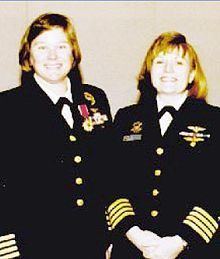Years of service 1973-1997 | Name Rosemary Mariner | |
 | ||
Allegiance United States of America | ||
Captain Rosemary Bryant Mariner was one of the first six women to earn their wings as a United States Naval Aviator in 1974. She was the first female military aviator to achieve command of an operational air squadron.
Contents

Early life and education
Mariner was born Rosemary Ann Merims. She grew up in San Diego, California, with a keen interest in aircraft and flying. She worked odd jobs and washed aircraft to earn money for flying lessons and flight time. She graduated from Purdue University in December 1972 at age 19 with a degree in Aviation Technology. She had earned FAA flight engineer and pilot ratings before she joined the Navy. While in the Navy, Mariner earned a Master's degree in National Security Strategy from the National War College.
Change to: Mariner was born Rosemary Ann Bryant, the daughter of an Air Force World War II and Korean War pilot, Cecil Bryant, and a former WWII Navy Nurse, Constance Boylan
Navy career
Rosemary Bryant Mariner (then Rosemary B. Conatser) joined the Naval service in 1973 after being selected as one of the first eight women to enter military pilot training. She completed women's Officer Candidate School in Newport, RI, then headed to Pensacola, FL for flight training. She was designated a naval Aviator in June 1974, one of the first six women to earn their wings as a United States Naval Aviator. The other five women to earn their wings were Barbara Allen Rainey, Jane Skiles O'Dea, Judith Ann Neuffer, Ana Marie Fuqua, and Joellen Drag. Mariner was among the first female military aviators to fly tactical jet aircraft, the A-4E/L Skyhawk, in 1975. In 1976, she converted to the A-7E Corsair II, the first woman to fly a front-line light attack aircraft.
In 1990 Mariner became the first military woman to command an operational aviation squadron and was selected for major aviation shore command. During Operation Desert Storm, she commanded Tactical Electronic Warfare Squadron Thirty Four (VAQ-34). Mariner was president of the Women Military Aviators organization from 1991 to 1993. Mariner retired after twenty-four years of military service, a veteran of seventeen carrier landings with over 3500 military flight hours in fifteen different naval aircraft.
Mariner's career is detailed in several books, including Crossed Currents: Navy Women from World War I to Tailhook, Women in the Military: An Unfinished Revolution, Tailspin: Women at War in the Wake of Tailhook, and Ground Zero: The Gender Wars in the Military.
Retirement
Mariner retired from the Navy with the rank of Captain at the end of 1997. Professor of Military Studies for the National War College. She is a Visiting Fellow with the Center for the Study of War and Society and Lecturer in History Department at the University of Tennessee at Knoxville.
